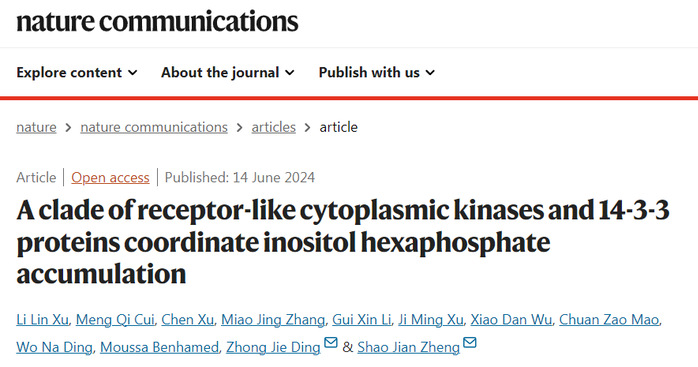
Title: A clade of receptor-like cytoplasmic kinases and 14-3-3 proteins coordinate the inositol hexaphosphate accumulation
Li Lin Xu, Meng Qi Cui, Chen Xu, Miao Jing Zhang, Gui Xin Li, Ji Ming Xu, Xiao Dan Wu, Chuan Zao Mao, Wo Na Ding, Moussa Benhamed, Zhong Jie Ding & Shao Jian Zheng
Abstract
Inositol hexaphosphate (InsP6) is the major storage form of phosphorus in seeds. Reducing seed InsP6 content is a breeding objective in agriculture, as InsP6 negatively impacts animal nutrition and the environment. Nevertheless, how InsP6 accumulation is regulated remains largely unknown. Here, we identify a clade of receptor-like cytoplasmic kinases (RLCKs), named Inositol Polyphosphate-related Cytoplasmic Kinases 1-6 (IPCK1-IPCK6), deeply involved in InsP6 accumulation. The InsP6 concentration is dramatically reduced in seeds of ipck quadruple (T-4m/C-4m) and quintuple (C-5m) mutants, accompanied with the obviously increase of phosphate (Pi) concentration. The plasma membrane-localized IPCKs recruit IPK1 involved in InsP6 synthesis, and facilitate its binding and activity via phosphorylation of GRF 14-3-3 proteins. IPCKs also recruit IPK2s and PI-PLCs required for InsP4/InsP5 and InsP3 biosynthesis respectively, to form a potential IPCK-GRF-PLC-IPK2-IPK1 complex. Our findings therefore uncover a regulatory mechanism of InsP6 accumulation governed by IPCKs, shedding light on the mechanisms of InsP biosynthesis in eukaryotes.
Link: https://www.nature.com/articles/s41467-024-49102-6






